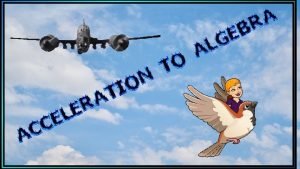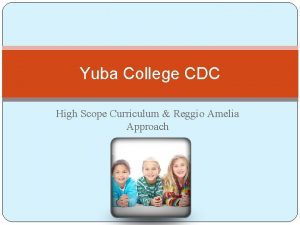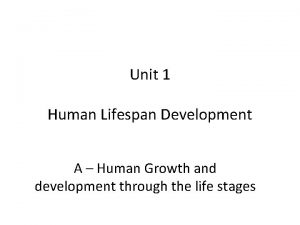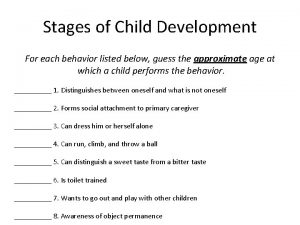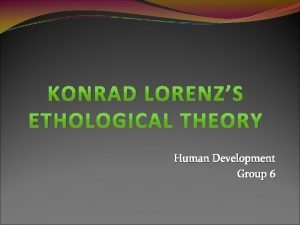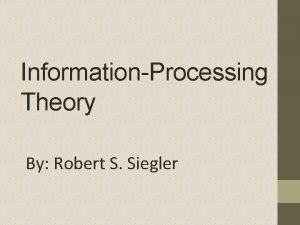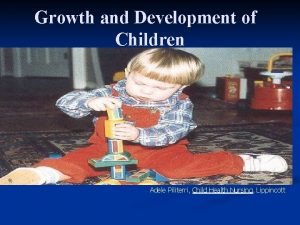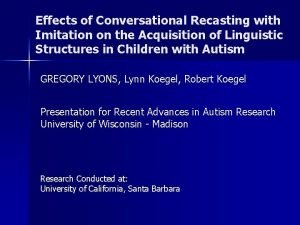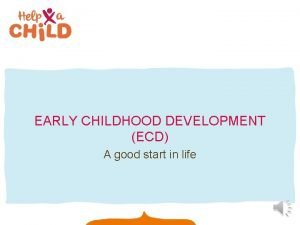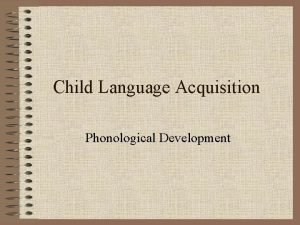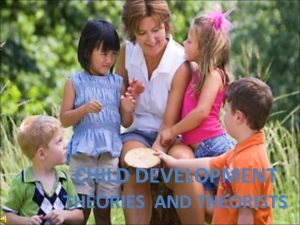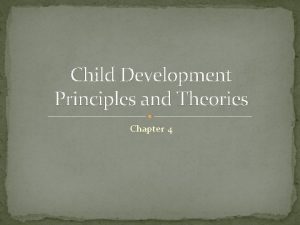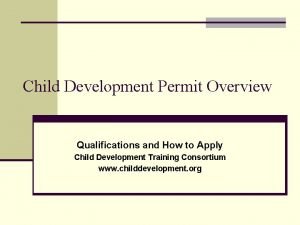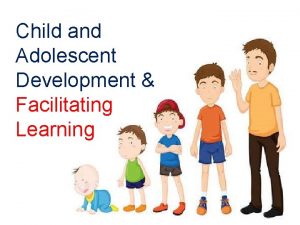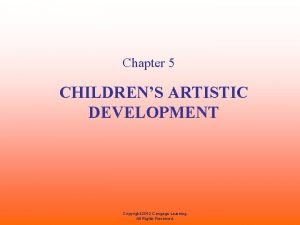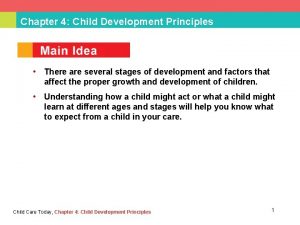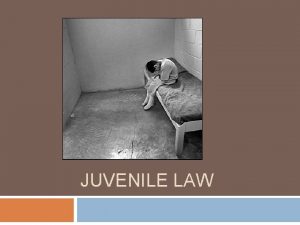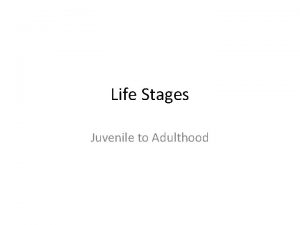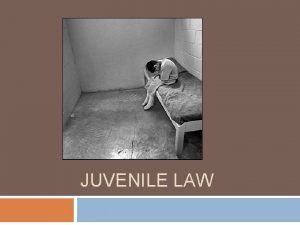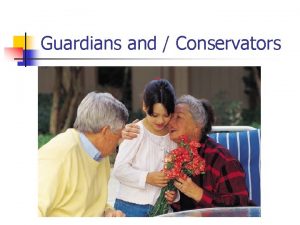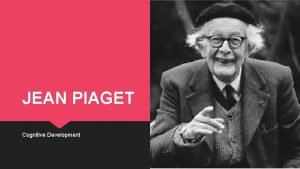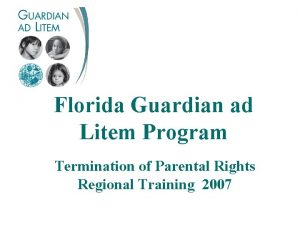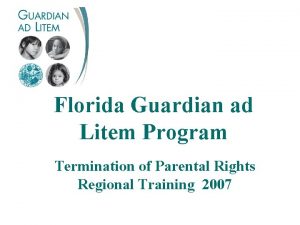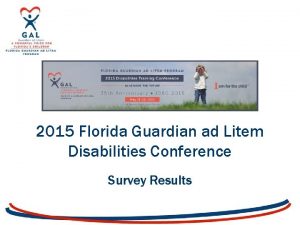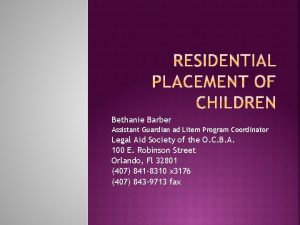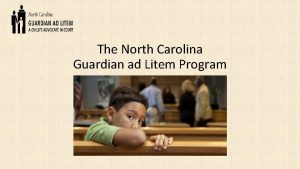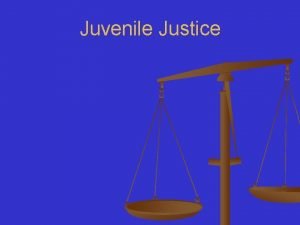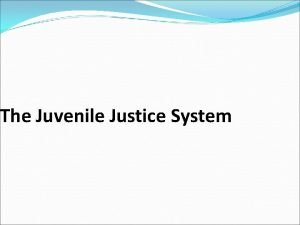Child Development for Guardians ad Litem in Juvenile




























































































- Slides: 92

Child Development for Guardians ad Litem in Juvenile Court Presented by: Theodora Phea Pinnock, M. D. , Developmental and Behavioral Pediatrician Phone: (615) 337 -4073 theodorapinnock@att. net 1

The Agenda Presentation n n n n Goals Development 101 Impact of Foster Care Specific Disorders Lunch Common Medications Case Studies Question & Answer References 2

Goals and Objectives Participant will learn about developmental milestones, some developmental assessment tools and how to interpret their results. Participant will learn about impact of foster care on development and common health and developmental problems for children in custody 3

Goals and Objectives Participant will learn about some mental health and developmental disorders affecting children in custody. Participant will learn about some common medications often used in children in foster care. Participants will use case studies to practically apply the presented information. 4

DEVELOPMENT 101: Birth to 4 years (Preschool) 5

6

Development 101: Birth to 4 Years (Preschool) Physical n Height and Weight, Head Circumference Growth charts Abnormalities: Genetic Defectsmetabolic, congenital; Failure to thrive; Prematurity n Body Mass Index “New Issue” 7

Development 101: Birth to 4 Years Developmental Milestones are a set of functional skills or age–specific tasks that most children can do at a certain age range n n n Gross motor- using large muscles-feeding walking; running; stairs, jumping, dress self, skipping Fine motor- using small muscles, balance-drawing figures, writing Language- 2 areas: expressive (what a child says) -jargon, words, sentences-short then long; receptive (what is said to child) -following commands 8

Development: Birth to 4 Years Developmental Milestones are a set of functional skills or age–specific tasks that most children can do at a certain age range n n Cognitive- problem solving- identify caregivers, identify simple pictures, memory formation Social- smiling, peek-a-boo; play with toys (i. e. dolls toys, etc. ), social play 9

Development: Birth to 4 Years Assessments that may be useful: Early Periodic Screening Diagnosis Treatment (EPSDT) well-child visits- ht & wt, BMI Screening Tests n n Developmental Milestones Behavior Developmental Tests n Occupational and Physical Therapy 10

US Trends for Boys (NHANES) 11

US Trends for Girls (NHANES) 12

Co-morbidities & Extreme Obesity 75% have > 1 related medical comorbidity 7 times the normal risk of diabetes 6 times the risk of hypertension 4 times the risk of arthritis 3 times the risk of asthma 4 times the risk of only fair to poor health 2 times the risk of all-cause mortality Hensrud, Mayo Clin Proc 2006: 81: s 5 Slide by Robert Murray, MD

Development: Birth to 4 Years Social and Emotional n Based on Erikson’s 8 stages of Development of Trust n n Developed in the period between birth to 1 year of age Babies depend on others for food, warmth, affection If babies get their needs met, they trust, develop bonds, etc; Bowlby et al say this period forms the basis of all social relationships If they don’t get their need met, they distrust, develop dysfunctional bonds and attachment issues 14

Development: Birth to 4 Years Development of Autonomy n n n Developed between 1 to 2 years of age Self-control and self-confidence begins to develop; separation anxiety comes into play If maltreatment, child may doubt abilities, may not learn to choose and may not develop good self control Development of Initiative n n n Developed between 2 to 6 years of age Impulse control and imagination begins to develop If maltreatment, child may not recognize limits, and may not develop independence 15

Development: Birth to 4 Years Intellectual and Psychological Development n Based on Jean Piaget’s 4 stages of Cognitive Development Sensory Motor Period n n Developed in the period between birth to 2 years of age Babies go from reflexes to intentional actions, learn object permanence, cause and effect 16

Development: Birth to 4 Years Preoperational Period n n n Developed in the period between 2 to 7 years of age Child begins to use egocentric speech (“I, me); speech then becomes more social Child goes from simple play to symbolic play Has language to represent and thoughts about objects without object being present Concepts formed are crude and reversible; from moral aspect- repeats do’s & don'ts 17

Recommendation for Court/Foster Care Review Board Length of Discussion 20 minutes maximum 18

DEVELOPMENT 101: 5 -14 years (Grades K-8) 19

20

Development: 5 to 14 Years (School age-Kindergarten thru 8 th Grade) Physical n Height and Weight Growth charts-secondary sex characteristics Gross Assessments of vision, hearing, teeth n Body Mass Index New Issue Nutritional Assessments n Diseases Asthma 21

US Trends (NHANES) 22

Medical Consequences of Obesity Psychosocial Medical n Lipidemia n Diabetes mellitus n Hypertension n Respiratory n Cardiac Medical n Polycystic ovary disease n Gall bladder disease n Osteoarthritis n Cancer n Steatohepatitis Mortality 23

Development: 5 to 14 Years Assessments that may be useful: EPSDT School n n Grades Screening Tests Occupational and Physical Therapy Achievement Tests Psychological Tests n n n Depression ADHD Conduct Disorder 24

Development: 5 to 14 Years Social and Emotional n Based on Erikson’s 8 stages of Development of Initiative n n n Developed between 2 to 6 years of age Impulse control and imagination begins to develop If maltreatment, child may not recognize limits, and may not develop independence 25

Development: 5 to 14 Years Development of Competence n n Developed between 6 to 12 years of age Children make things, use tools acquire some potential skills to be a worker Transition begins from world of home to world of peers If maltreatment, child may not take initiative, and may see themselves as inferior 26

Development: 5 to 14 years Development of Identity n n n Developed between 12 to 18 years of age Preadolescents and adolescents ask the questions “Who am I? ” If teen has trouble with trust, autonomy, initiative and competence, he/she may sink into confusion, unable to make choices especially about vocation, sexual orientation and role in life in general. 27

Development: 5 to 14 Years Intellectual and Psychological Development n Based on Jean Piaget’s 4 stages of Cognitive Development Preoperational Period n n n Developed in the period between 2 to 7 years of age Child begins to use egocentric speech (“I, me); speech then becomes more social Child goes from simple play to symbolic play Has language to represent and thoughts about objects without object being present Concepts formed are crude and reversible; from moral aspect- repeats do’s & don'ts 28

Development: 5 to 14 Years Period of Concrete Operations n n n Developed in the period between 7 to 11 years of age Child begins to organized logical thought Child begins to categorically label objects, classify and sequence 29

Development: 5 to 14 Years Period of Formal Operations n n Developed in the period between 11 to 15 years of age Teen begins to form more abstract thoughts Teen can develop multiple hypotheses, think through potential outcomes Teen starts to think as-if and if-then steps 30

Recommendation for Court/FCRB Length of discussion for 5 to 10 years 30 minutes maximum. 31

Recommendation for Court/FCRB Length of discussion for 11 -14 years: Entire time needed 32

DEVELOPMENT 101: 15 -18 years (Grades 9 -12) 33

34

Development: 15 to 18 Years (School age- 9 thru 12 th Grade) Physical n Height and Weight Growth charts- secondary sex characteristics n Body Mass Index New Issue Nutritional Assessments 35

Development: 15 to 18 Years (School age- 9 thru 12 th Grade) Physical n Diseases/Disorders Asthma Acne Eating Disorders n Sexual Activity Pregnancy, Sexually transmitted Diseases 36

Tennessee Trends Youth Risk Behavior Risk Surveillance Survey

Obesity & Psychological Issues Victimization/ bullying Sense of alienation Depression Behavioral problems Lifelong low quality of life Low self-esteem

Development: 15 to 18 Years Assessments the may be useful: EPSDT School n n Grades Screening Tests Vocational Assessments Achievement Tests Psychological Tests n n n Depression ADHD Conduct Disorder 39

Development: 15 to 18 Years Social and Emotional n Based on Erikson’s 8 stages of Development of Identity n n n Developed between 12 to 18 years of age Preadolescents and adolescents ask the questions “Who am I? ” If teen has trouble with trust, autonomy, initiative and competence, he/she may sink into confusion, unable to make choices especially about vocation, sexual orientation and role in life in general. 40

Development: 15 to 18 Years Intellectual and Psychological Development n Based on Jean Piaget’s 4 stages of Cognitive Development Period of Formal Operations n n Developed in the period between 11 to 15 years of age Teen begins to form more abstract thoughts Teen can develop multiple hypotheses, think through potential outcomes Teen starts to think as-if and if-then steps 41

Recommendation for Court/FCRB Length of discussion for 11 -14 years: Entire time needed 42

SESSION 2: IMPACT ON FOSTER CARE 43

Statistics In September 2006, 510, 000 children in foster care Average length of stay is 28. 3 months n 37% of children spent < 11 months n 24% of children spent 3 years or longer 85% of children in care < 1 year experience 2 or fewer placements, with the # of placements increasing with each year a child spends in the system 49% of children reunite with their families but trends show the rate declining Source: Jan 2008, Adoption and Foster Care Analysis and Reporting System (AFCARS) Preliminary FY 2006 Estimates 44

Impact The Top Health Issues for Foster Children n n Immunizations not current Inadequate treatment for chronic diseases such as asthma, allergies (eczema), ear infections Inadequate treatment for acute conditions such as ear infections, dental conditions (caries, abscess) Doesn’t receive well visits and miss out on potential preventative care 45

Impact The Top Health Issues for Foster Children (Continued) n n n High prevalence of developmental disorders High prevalence of mental health disorders and behavioral problems High prevalence of substance use disorders 46

Statistics CPORT Results : Children in Custody n n 50% of the children had a Mental Health Diagnosis 44% with both Mental Health and Substance Abuse Diagnoses Department of Health Results n n >92% of children receive timely EPSDT exams > 90% of children receive immunizations 47

Statistics CPORT Results : Juveniles in Custody n n n n 83% with Mental Health Diagnosis 12% of their parents with Mental Health Diagnosis 79% with Substance Abuse Diagnosis 55% with Polysubstance Abuse issues 66% with both Mental Health and Substance abuse issue 37% with a learning disability 25% with ADHD diagnosis 75% are sexually active 48

Developmental Disabilities Economic n $30, 000 to $100, 000 per child 49

Benefits of Addressing Developmental Disabilities EARLY Delayed pregnancy Higher employment rates Decreased criminality Higher HS graduation rates 50

VISITATION Recommendations n n n Length Responses Transition 51

2 Moro N TN EPSDT Form: State Seal STATE OF TENNESSEE DEPARTMENT OF HEALTH Dear Dr. _________, We provided a Child Health/EPSDT (early, periodic, screening, diagnosis and treatment) examination on _______ for your patient, __________________________ (date) Unless otherwise noted in the “Addition Comments” section below, the examination included the seven required components: Comprehensive history including interval history, and developmental history (includes developmental and behavior screening) Hearing Assessment Physical Examination-unclothed Vision Assessment Health Education Laboratory Test Immunizations-up to date: Yes___ No ___ (see attached copy) All screening results were within normal limits at this time. Referable Conditions _______________________________________________________________________ ____________________________________ Lab Results Pending- will notify if abnormal Additional Comments: ___________________________________________________________________________ __________________________________________________________________ Referral has been made to: Dental Tennessee Early Intervention System (unless seen in past 6 months) _____________________ Provider Signature County Date White-PCP Canary-DCS/CM Pink-Agency PH-3789 (Rev 2/05) RDA 150 52

SESSION 3: SPECIFIC DISORDERS 53

Specific Disorders Attention Deficit Hyperactivity Disorder (ADHD) Autism Spectrum Disorder Bipolar Disorder Post Traumatic Stress Disorder 54

ADHD 2003 National Survey of Children’s Health-4. 4 million children n Prevalence greater in non-Hispanic English speaking families with health insurance Males more likely than females to receive medication Minority children less likely to be taking medication than white counterparts. American Psychiatric Association 1994: 78 -85

ADHD Incidence : 3 -5% of school age children Male to female ratio varies from 2: 1 to 10: 1, average of 6: 1 n n Higher number of males may be due to referral bias Girls: later age of diagnosis more often inattentive type fewer oppositional defiant disorder (ODD) and conduct disorder (CD) symptoms American Psychiatric Association 1994: 78 -85

ADHD ©Disney, Inc.

Definition of ADHD Diagnostic and Statistical Manual of Mental Disorders, 4 th Edition (DSM IV) A. Either 1 or 2 1. Six (or more) of the following symptoms of INATTENTION have persisted for at least six months to a degree that is maladaptive: n Often fails to give close attention to details or makes careless mistakes in schoolwork, or other activities n Often has difficulty sustaining attention in tasks or play activities n Often does not seem to listen when spoken to directly n Often does not follow through on instructions and fails to finish schoolwork, chores, or duties in the workplace (not due to oppositional behavior or failure to understand the instructions)

Definition of ADHD Inattention (continued) n n n Often has difficulty organizing tasks and activities Often avoids, dislikes, or is reluctant to engage in tasks that require sustained mental effort (such as schoolwork or homework) Often loses things necessary for tasks or activities (e. g. toys, school assignments, pencils, books or tools) Is often easily distracted by extraneous stimuli Is often forgetful in daily activities

Definition of ADHD Impulsivity n n n Often blurts out answers before questions have been completed Often has difficulty awaiting turn Often interrupts or intrudes on others (e. g. butts into conversations or games

Definition of ADHD 2. Six (or more) of the following symptoms of HYPERACTIVITY-IMPULSIVITY have persisted for at least six months to a degree that is maladaptive or inconsistent with developmental level: n Often fidgets with hands or feet or squirms in seats n Often leaves seat in classroom or in other situations in which remaining seated is expected n Often runs about or climbs excessively in situations in which it is inappropriate (in adolescents or adults, may be limited to subjective feelings of restlessness) n Often has difficulty playing or engaging in leisure activities quietly Is often “on the go” or often acts as if “driven by a motor” n Often talks excessively

Definition of ADHD B. Some hyperactive-impulsive or inattentive symptoms that caused impairment were present before 7 years of age C. Some impairment from the symptoms is present in two or more settings D. There must be clear evidence of clinically significant impairment in social, academic, or occupational functioning. E. The symptoms do not occur exclusively during the course of pervasive development disorder, schizophrenia, or other psychotic disorder and are not better accounted for by another mental disorder (e. g. mood disorder, anxiety disorder, dissociative disorder, or personality disorder).

ASD In 2007, Centers for Disease Control (CDC) reported the incidence of ASD was 1 in 150 children. In 2010, the CDC reported the incidence to be 1 in 110, 1 in 80 for boys 63

Definition of ASD Diagnostic and Statistical Manual of Mental Disorders, 4 th Edition (DSM IV) – disorders known as Pervasive Developmental Disorders Described as Autism Spectrum Disorders – has 5 disorders: Autism, Asperger’s Syndrome (most common); Pervasive Developmental Delay Not Otherwise Specified; Rett Syndrome; Childhood Disintegrative Disorder

ASD All children with ASD demonstrate deficits 1) social interaction; 2) verbal and nonverbal communication; and 3) repetitive behaviors or interests.

ASD In addition, they will often have unusual responses to sensory experiences, such as certain sounds or the way objects look. Each of these symptoms runs the gamut from mild to severe. They will present in each individual child differently. For instance, a child may have little trouble learning to read but exhibit extremely poor social interaction. Each child will display communication, social, and behavioral patterns that are individual but fit into the overall diagnosis of ASD

ASD Does not babble, point, or make meaningful gestures by 1 year of age Does not speak one word by 16 months Does not combine two words by 2 years Does not respond to name Loses language or social skills Head Start 2008

ASD Some Other Indicators Poor eye contact Doesn't seem to know how to play with toys Excessively lines up toys or other objects Is attached to one particular toy or object Doesn't smile At times seems to be hearing impaired Head Start 2008

Bipolar Disorder DSM-IV definition of Bipolar 1: The essential feature of Bipolar I Disorder is a clinical course that is characterized by the occurrence of one or more Manic Episodes or Mixed Episodes. Often individuals have also had one or more Major Depressive Episodes. Rule out Substance-Induced Mood Disorder, Schizophrenia, Schizoaffective Disorder. 69

Bipolar Disorder DSM-IV definition of Bipolar 2: The essential feature of Bipolar II Disorder is a clinical course that is characterized by the occurrence of one or more Major Depressive Episodes accompanied by at least one Hypomanic Episodes should not be confused with the several days of euthymia that may follow remission of a Major Depressive Episode. Rule out Substance- Induced Mood Disorder, Schizoaffective Disorder , Schizophrenia, Schizophreniform Disorder, Delusional Disorder, or Psychotic Disorder Not Otherwise Specified. 70

Incidence of Bipolar Disorder The researchers estimated that in the United States from 1994 -1995, the number of office visits resulting in a diagnosis of bipolar disorder for youths ages 19 and younger was 25 out of every 100, 000 people. By 2002 -2003, the number had jumped to 1, 003 office visits resulting in bipolar diagnoses per 100, 000 people. (increased 40 X over the last decade) 71

SESSION 4: COMMON MEDICATIONS 72

Treatment of ADHD Treat Co-morbid Conditions!!!! Overview n Stimulants Ritalin/Ritalin XR Ritalin LA-Methyphenidate Methylin/Methylin ER -Methlyphenidate Metadate ER/Metadate CD-Methylphenidate Foculin/Focalin XR-Methylphenidate Daytrana (patch)- Methylphenidate Concerta- Methylphenidate Vyvanase- Dextroampetamine Head Start 2008

Medications Medication Therapy n Stimulants: Works primarily on the dopamine system Methylphenidate HCL (Ritalin), Amphetamine (Dexadrine)) Dexadrine (Dextramphetamine) Adderall Concerta n Non-stimulants: Works primarily on the norepinephrine system ( Tricyclics, Bupropion, Clonidine, Guanfacine, Atomoxetine) Contemporary Pediatric Supplement Lamictal n Other. Tegretol, February 2003 NMA 2005

Medications Medication Therapy n Psychotrophic Meds Abilify-Schizophrenia, bipolar disorder Risperdal-Schizophrenia Seroquel-Schizophrenia Cymbalta-Depression Pamelor- Depression Prozac-Depression Pristiq-Depression Zoloft-Depression Trazodone--Depression

MEDICATION Documentation n n Dosage & administration Summary of effectiveness-minimum of quarterly Appropriate Lab tests scheduled 76

SESSION 5: CASE STUDIES 77

Case Study #1 Jose is a 16 year old young man, who came into custody in August 2010 for neglect and abuse. His date of birth is 7/31/94. He has been placed in a different foster home than his 13 y/o sister and 6 year old brother. His permanency goals are: 1) return to parent; and 2) exit custody. Jose is in the 11 th grade but will not graduate prior to turning 18. He is a bright young man but his grades do not reflect his ability. Jose has missed a lot of days from school. He spent a lot of time at neighbor’s trailer two doors down, which is a known drug house. He admits to “drinking a lot of beer” and being “sad” most of the time. His body mass index (BMI) is 29, in the obese range. He has several obvious cavities. 78

Case Study #1 Jose‘s mental health diagnoses are Bipolar Disorder and ADHD. His medications include Focalin, Seroquel, Abilify and Zyprexa. Recently, he has been complaining of frequent headaches and “feeling anxious. ” 79

Case Study #2 Denise is a 3 year old young girl, who came into custody in September 2009 for neglect. Her father was arrested and is currently in jail for writing bad checks Her mother is now out of jail for drug charges and is working part-time. Her date of birth is 3/9/08. She is staying in a foster home with her younger brother, who is 2 years old. Her two older brothers, 7 & 5 years old, are staying in another foster home. The permanency goals are: 1) to return to parent; and 2) adoption. Denise’s speech was noted to be delayed on the EPSDT summary form. She has less than 25 words, makes little eye contact and often does not answer or respond to the calling of her name. Her immunizations are also behind. 80

Case Study #2 Denise and her brother get supervised visits with her mother for 4 hours a month. She has not seen her older siblings but once since she entered custody. She will start Early Head Start this fall. 81

Case Study #3 Billy Joe Parker is a 7 year old boy who came into custody in 2008 for physical abuse and neglect. He was taken into custody after his parents were arrested while making methamphetamine in their home. Their parental rights are in the process of being terminated. Billy Joe is the oldest of three children and has not seen his siblings in over a year, as they reside in another foster home. His sister is 5 and brother is 3. 82

Case Study #3 On his most recent EPSDT health exam his BMI is greater than the 85 th percentile, BP 94/50. His physical exam is otherwise normal. He is not doing well in school. He just started his third school in the last year. He cannot read. His math skills are at the kindergarten level. He is described as “always daydreaming. ” 83

Encouragement “God doesn’t call us to be successful, He calls us to be faithful. ” Mother Teresa 84

SESSION 6: QUESTIONS AND ANSWERS 85

86

References AAP Policy Statement. “Health Care of Young Children in Foster Care. ” Pediatrics. 2002; Vol. 109: No. 3, pp. 536 -541. AAP Policy Statement. “Developmental Issues for Young Children in Foster Care. ” Pediatrics. 2000; Vol. 106: No. 5, pp. 1145 -1150. Simms, M. D. et al. “Needs of Children in the Foster Care System. ” Pediatrics. 2000: Vol. 106: (Supplement), pp. 909 -918. Website: http: //www. cwla. org/programs/health/default. htm. 87

References Websites n n n http: //www. cfw. tufts. edu/? /category/familyparenting/2/topic/foster-care/28. http: //www. hunter. cuny. edu/socwork/nrcfc pp/info_services/mental-health. html. www. babycenter. com/refcap/toddlerdevelo pment PEDS-www. dbpeds. org A&SQwww. massgeneral. org/children/psc_h ome. htm 88

References Websites n n n n www. baycenter. com/refcap/toddlerdevelopment PEDS- www. dbpeds. org A&SQwwww. massgeneral. org/children/psc_home. html www. childdevelopmentinfo. com/development/piaget. s html www. childdevelopmentinfo. com/development/teens_s tages. shtml www. elainegibson. net/parenting/devlopment. html www. futureofchildren. org 89

References n n n n Websites www. ldonline. org/ld_indepth/early_identification/norm al_development. html http: //psychology. about. com/library/weekly/aa 09150 0 a. htm http: //psychology. about. com www. wholefamily. com/aboutyourkids/child/normal/p hysical_development www. elainegibson. net/parenting/devlopment. html www. futureofchildren. org 90

References http: //pediatrics. aappublications. org/cgi/content/full/109 5/733 http: //www. parentsofallergicchildren. org/diagnosis. htm http: //concensus. nih. gov/cons/110_statement. htm http: //www. cdc. gov/mmwr/preview/mmwrhtml/mm 5434 a 2. htm Barkley, RA. Attention-Deficit Hyperactivity Disorder: A Handbook for Diagnosis and Treatment. 3 rd ed. New York, NY: Guilford Press; 2006. Gephart, H & Laurel, L: ”ADHD Pharmacotherapy. ” Contemporary Pediatrics December 2006; 23: 54. Head Start 2008

References http: //www. nimh. nih. gov/health/publications/autism/c omplete-publication. shtml http: //www. cdc. gov/ncbddd/autism/ American Psychiatric Association. Diagnostic and statistical manual of mental disorders: DSM-IV-TR (fourth edition, text revision). Washington DC: American Psychiatric Association, 2000. Filipek PA, Accardo PJ, Baranek GT, Cook Jr. EH, Dawson G, Gordon B, Gravel JS, Johnson CP, Kellen RJ, Levy SE, Minshew NJ, Prizant BM, Rapin I, Rogers SJ, Stone WL, Teplin S, Tuchman RF, Volkmar FR. The screening and diagnosis of autism spectrum disorders. Journal of Autism and Developmental Disorders, 1999; 29(2): 439 -484. Head Start 2008
 Americas guardians mc
Americas guardians mc Welcome parents and guardians
Welcome parents and guardians 승자트리
승자트리 Kontinuitetshantering i praktiken
Kontinuitetshantering i praktiken Novell typiska drag
Novell typiska drag Tack för att ni lyssnade bild
Tack för att ni lyssnade bild Returpilarna
Returpilarna Shingelfrisyren
Shingelfrisyren En lathund för arbete med kontinuitetshantering
En lathund för arbete med kontinuitetshantering Underlag för särskild löneskatt på pensionskostnader
Underlag för särskild löneskatt på pensionskostnader Personlig tidbok
Personlig tidbok Anatomi organ reproduksi
Anatomi organ reproduksi Densitet vatten
Densitet vatten Datorkunskap för nybörjare
Datorkunskap för nybörjare Boverket ka
Boverket ka Debattartikel mall
Debattartikel mall Magnetsjukhus
Magnetsjukhus Nyckelkompetenser för livslångt lärande
Nyckelkompetenser för livslångt lärande Påbyggnader för flakfordon
Påbyggnader för flakfordon Formel för lufttryck
Formel för lufttryck Publik sektor
Publik sektor Lyckans minut erik lindorm analys
Lyckans minut erik lindorm analys Presentera för publik crossboss
Presentera för publik crossboss Jiddisch
Jiddisch Kanaans land
Kanaans land Treserva lathund
Treserva lathund Luftstrupen för medicinare
Luftstrupen för medicinare Bästa kameran för astrofoto
Bästa kameran för astrofoto Centrum för kunskap och säkerhet
Centrum för kunskap och säkerhet Programskede byggprocessen
Programskede byggprocessen Mat för idrottare
Mat för idrottare Verktyg för automatisering av utbetalningar
Verktyg för automatisering av utbetalningar Rutin för avvikelsehantering
Rutin för avvikelsehantering Smärtskolan kunskap för livet
Smärtskolan kunskap för livet Ministerstyre för och nackdelar
Ministerstyre för och nackdelar Tack för att ni har lyssnat
Tack för att ni har lyssnat Referat mall
Referat mall Redogör för vad psykologi är
Redogör för vad psykologi är Borstål, egenskaper
Borstål, egenskaper Atmosfr
Atmosfr Borra hål för knoppar
Borra hål för knoppar Orubbliga rättigheter
Orubbliga rättigheter Variansen formel
Variansen formel Tack för att ni har lyssnat
Tack för att ni har lyssnat Steg för steg rita
Steg för steg rita Vad är verksamhetsanalys
Vad är verksamhetsanalys Tobinskatten för och nackdelar
Tobinskatten för och nackdelar Blomman för dagen drog
Blomman för dagen drog Handledning reflektionsmodellen
Handledning reflektionsmodellen Egg för emanuel
Egg för emanuel Elektronik för barn
Elektronik för barn Antikt plagg i rom
Antikt plagg i rom Strategi för svensk viltförvaltning
Strategi för svensk viltförvaltning Kung dog 1611
Kung dog 1611 Indikation för kejsarsnitt på moderns önskan
Indikation för kejsarsnitt på moderns önskan Ro i rom pax
Ro i rom pax Tack för att ni lyssnade
Tack för att ni lyssnade Enheter för massa
Enheter för massa Olika rim dikter
Olika rim dikter Inköpsprocessen steg för steg
Inköpsprocessen steg för steg Fuktmätningar i betong enlig rbk
Fuktmätningar i betong enlig rbk Ledarskapsteorier
Ledarskapsteorier Aktiv exspektans
Aktiv exspektans Myndigheten för delaktighet
Myndigheten för delaktighet Trög för kemist
Trög för kemist Sju principer för tillitsbaserad styrning
Sju principer för tillitsbaserad styrning Läkarutlåtande för livränta
Läkarutlåtande för livränta Karttecken
Karttecken Geometri för barn
Geometri för barn Shivaismen
Shivaismen Meios steg för steg
Meios steg för steg Bris för vuxna
Bris för vuxna Jätte råtta
Jätte råtta Yuba college child development center
Yuba college child development center Bowlby theory child development
Bowlby theory child development Complexive concepts
Complexive concepts Example of assimilation in child development
Example of assimilation in child development Harbor college child development center
Harbor college child development center Lorenz ethological theory
Lorenz ethological theory Siegler's information processing skills
Siegler's information processing skills School-age child development stages
School-age child development stages What is recasting in language development
What is recasting in language development Child development matrix
Child development matrix Berko and brown fish
Berko and brown fish Female child development theorists
Female child development theorists Child development principles and theories
Child development principles and theories Child development associate teacher permit
Child development associate teacher permit Child development permit
Child development permit Berk child development
Berk child development Chapter 9 intellectual development in the first year
Chapter 9 intellectual development in the first year Scaffold and fade-away technique
Scaffold and fade-away technique Theories of child art development
Theories of child art development Chapter 4 child development
Chapter 4 child development

